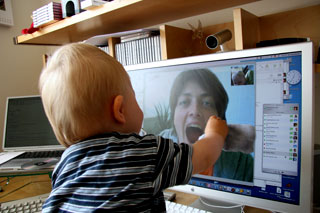
Video
Hey I can see you!
As I stated before, video breaks down our physical image and reconfigures it as digital image to someone else. I believe this is the closest we can get to face-to-face relations, pending the travel time of the information to process and display ourselves over the Web.
In the study at the University of Michigan, Ann Arbor mentioned earlier, “the video groups achieved the same levels of trust as the face-to-face groups” (Bos et all 291). This is somewhat predictable, since it is close as possible we can achieve to simulating face-to-face connections. Video chat can be labeled to be a true type of tele-presence since the people are conversing from two different locations but able to hear and see each other.
Wait, you can see me too!
Video chat is relatively new and is marketed to a degree, but not popularly integrated yet. I restate that it is a convenience rather than a necessity, even though it provides the highest level of trust. I believe this attitude of putting aside video chat is due in part to self-consciousness. While we speak to people in our normal lives, we unconsciously take note of the vulnerability of our image to people around us. While confined to a computer screen however, one realizes that image is everything: not only can we see ourselves on the screen, but we are under direct scrutiny with whomever we are video-chatting. One becomes severely conscious of one’s own action and how these actions are portrayed. This has to do partly with perspective. Unlike the outside real world where one has the ability to view things from all angles, one is confined to one perspective, the computer.
“…trust in the face-to-face condition forms quickly, and continues throughout. Video also converges at the maximum, but takes somewhat longer…” (Bos et all, 292). Undoubtedly, one gains trust in personal contact, so it makes sense the video comes in at a close second as imitating reality through a digital projection of ourselves.







